It is a truth universally acknowledged that of all creatures, great and small, the mosquito is the absolute worst.
It is the most deadly species on the planet, killing over one million people a year. While scientists have argued against the wholesale eradication of these bloodthirsty pests – they’re not entirely useless: they’re pollinators and have their place in the food chain – many would gladly see them gone. Imagine a world with no mosquitoes; it’s easy if you try.
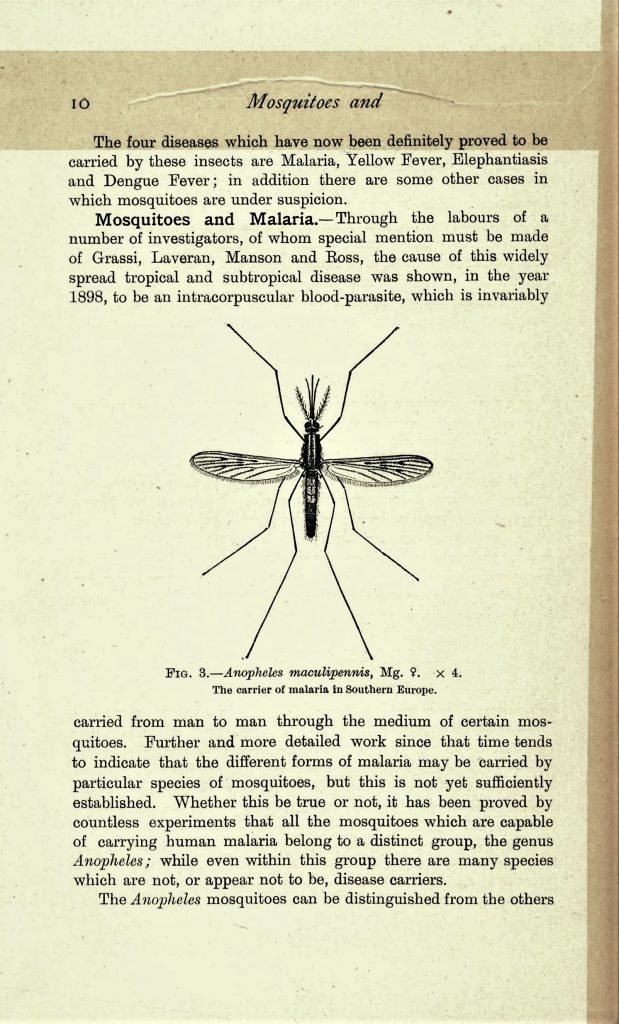
Mosquitoes are an evergreen subject of research in disease ecology and public health. Recent studies have linked climate change to the growth of mosquito populations, and, as a result, the spread of mosquito-borne disease. In 2017, the Museum Support Center Library received a large gift donation of monographs and serials from the Armed Forces Pest Management Board library. Working with the Smithsonian’s Walter Reed Biosystematics Unit, Libraries staff acquired a significant amount of monographs, technical reports, and serials relating to parasite and insect spread vector-borne diseases. The materials are valuable resources for entomological researchers mapping mosquito populations.
While the link between climate change and mosquitoes has been just recently uncovered, malaria has menaced man for millennia. The deadly disease was written about as early as 4th Century Ancient Greece and some blame the pathogen for toppling Alexander the Great. It wasn’t until the early 1800s that scientists pinpointed parasites as the cause of the disease and mosquitoes as their preferred mode of transportation.
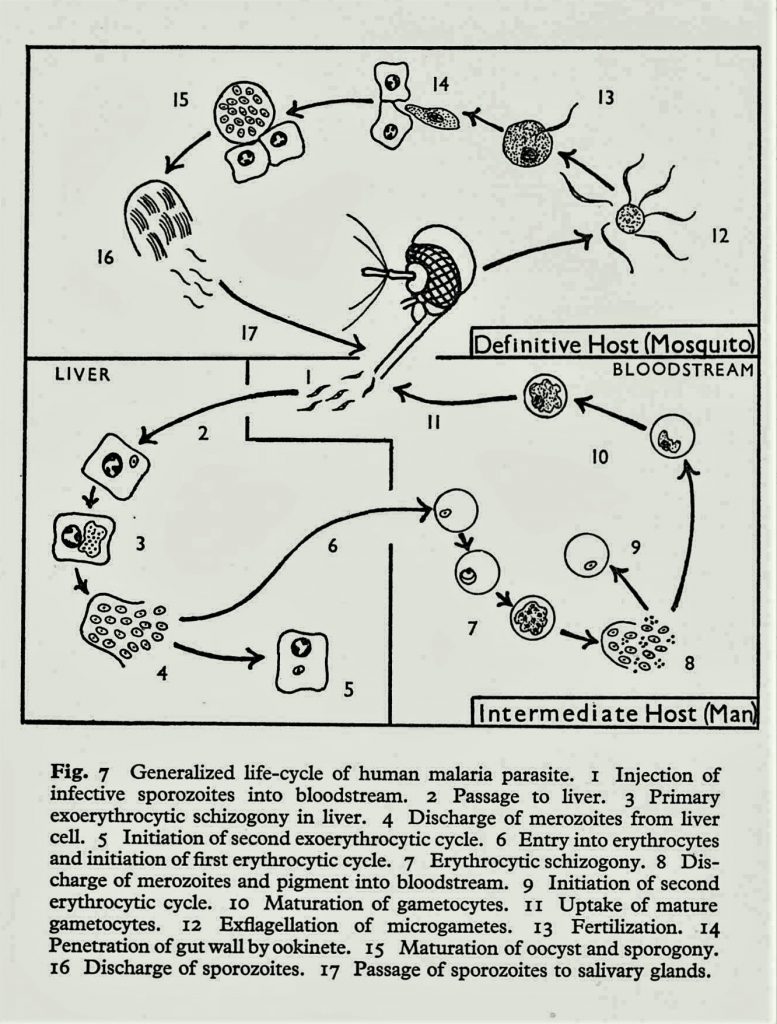
In 1821, French scientists separated the alkaloid quinine from the chincona tree – a plant native to South America and locally known for its ability to ease the suffering of those infected with malaria. An enterprising German physician, Carl Warburg, created “Warburg’s Tincture” in 1832 and immediately restricted knowledge of the formula—beating out Coca-Cola for the title of “first herbal brew with closely guarded secret recipe” by nearly 60 years. Armed with this chemoprophylaxis, the British government sent bottles of Warburg’s Tincture to every corner of its sun-drenched empire.

While the world was aware that quinine was one of the best defenses against mosquito-borne malaria, it was in no way readily available. In classic example of European imperialism, the Dutch held a monopoly on chincona tree forests and charged a king’s ransom for the precious medicine. Despite the British government’s best efforts to protect its subjects, malaria was still the #1 cause of death in India, claiming thousands of lives. Chemists across the British Isles holed up in their laboratories, desperate to find a more cost-effective substitute for the costly quinine.
One such chemist was William Henry Perkin, a young student at the Royal College of Chemistry and a protégé of the school’s director, August Wilhelm von Hofmann. Hofmann was experimenting with coal tar, a toxic industrial waste product, breaking down its components to their nitrogen bases, called amines. Quinine is also an amine and therefore has a chemical structure similar to many coal tar components. Hofmann, highly skeptical yet curious, tasked the teenaged Perkin with synthesizing quinine from coal tar.
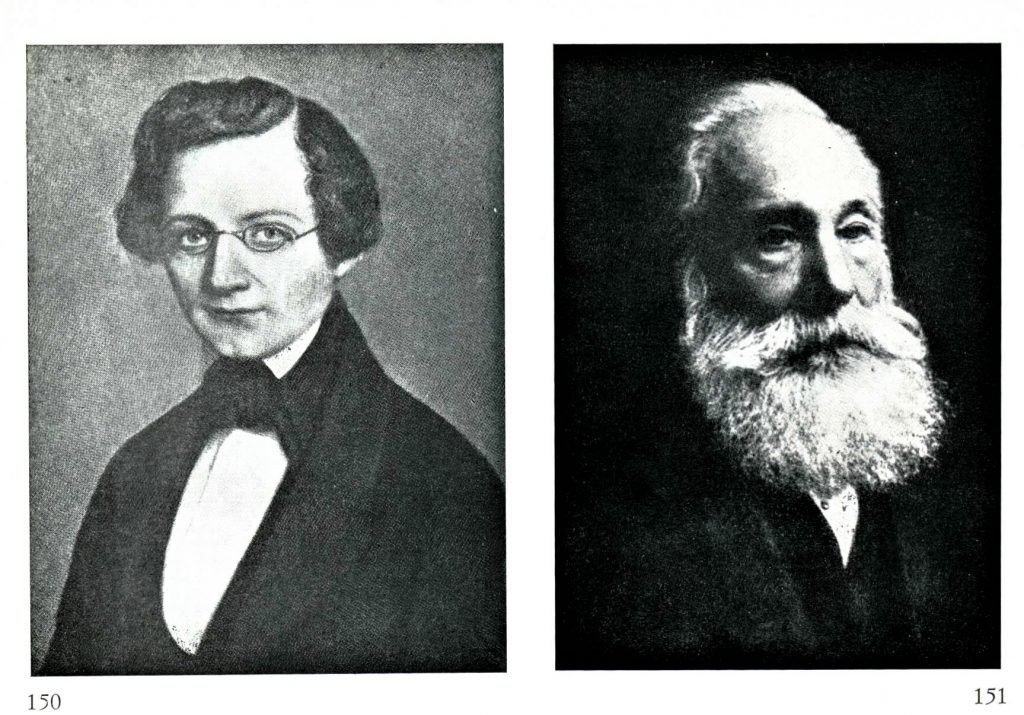
In 1856, while experimenting at home during Easter break, 18 year old William Perkin became the first person to ever create a synthetic dye – entirely by accident.
After a failed attempt created black goo instead of clear liquid, Perkin attempted to wash out his test tubes for another run. However, a bright purple residue clung to the glass, and after rinsing with alcohol, Perkin noticed that the solution had stained his cotton washcloth the same brilliant shade. Intrigued, Perkin began a new set of experiments, easily dyeing silk and determining the colorfastness of his invention. Understanding the implications of his discovery, Perkin quickly filed a patent and left the Royal College to start his own business. Within a year, the family-run company moved from his parents’ attic to a large factory on the outskirts of London.
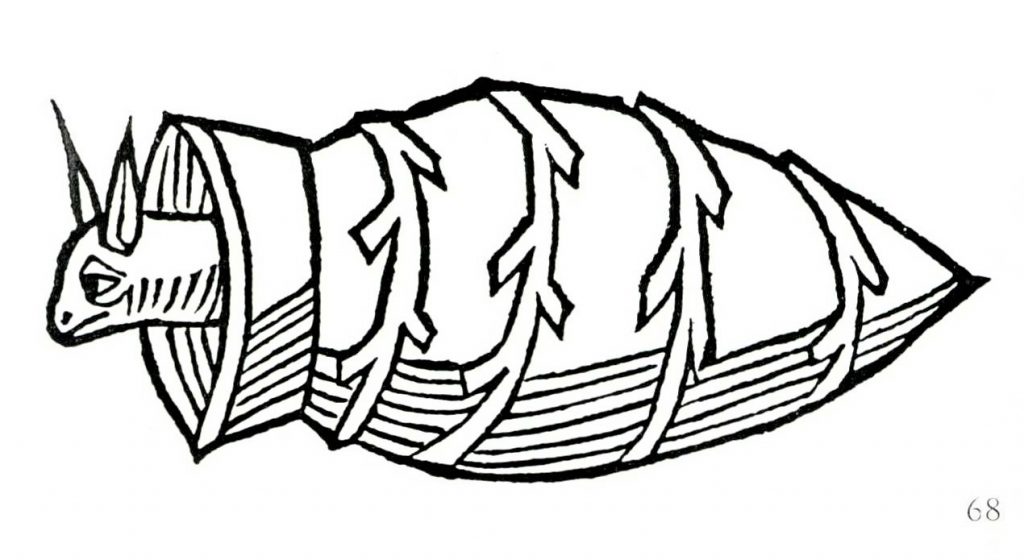
Perkin originally named his creation “Tyrian purple” after the legendary hue. Incredibly expensive and difficult to produce, the original Tyrian purple pigment came from predatory sea snails found in the Eastern Mediterranean. Reserved only for the powerful and absurdly wealthy of the ancient world (Julius Caesar was draped in Tyrian purple robes when he was assassinated and Cleopatra dyed the sails of her royal barge the same shade), production of the dye faded with the Roman Empire. A millennia later, William Perkin brought the famed pigment back to life.
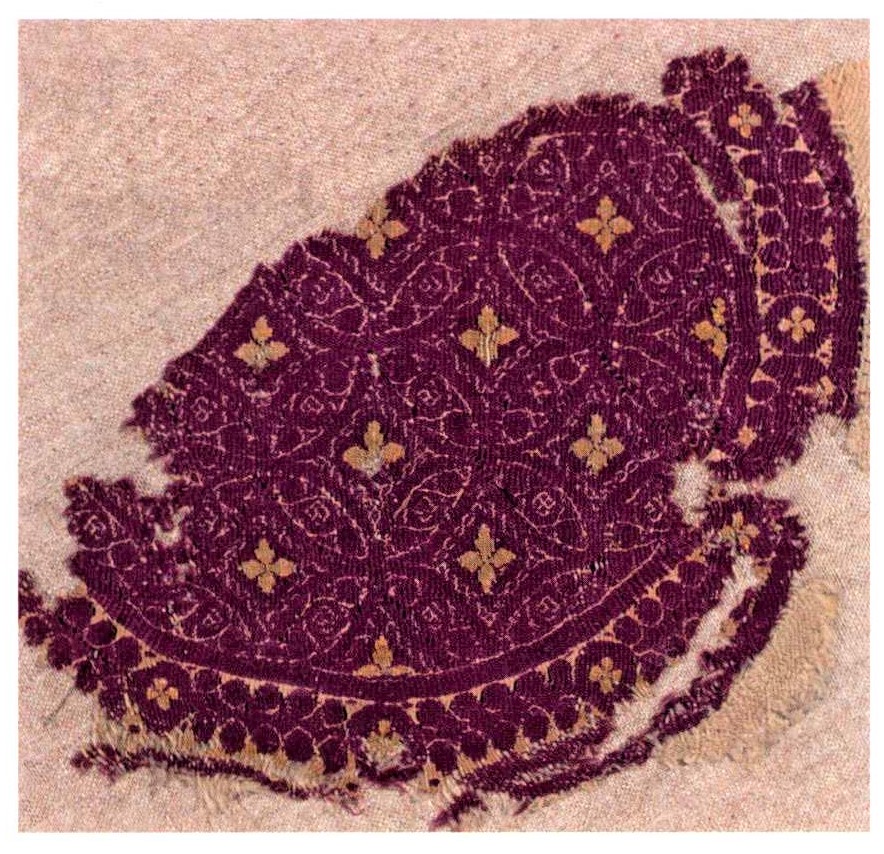
For the first time in history, however, rich purples were not relegated to royalty. While purple was a particular favorite shade of Empress Eugenie of France, and Queen Victoria was so taken with the hue that she wore a mauveine dress to her daughter’s wedding, synthetic dyes were cheap and easy to make. Coal tar was a waste product and therefore readily available; chemists across Europe raced to synthesize their own aniline dyes in a rainbow of shades.

Of course, fashion is notoriously cyclical: while Technicolor aniline dyes were all the rage at the beginning of the 20th century, current trends favor naturally sourced dyes. Science and technology now enable fashionistas to be as eco-conscious as they are stylish. But for those who study the history of clothing – especially the scientists at the Museum Conservation Institute – aniline dyes will never be totally obsolete.
The Museum Support Center Library has a number of monographs and journals devoted to the production and use of synthetic dyes. These journals, the oldest of which date to 1879, are valuable resources for the staff at the Museum Conservation Institute, who review these older titles in order to better understand the chemical composition of dyed fragile textiles.

Two of the oldest periodicals are the Journal of the Society of Dyers and Colourists and Textile colorist. Both cover the science and application of colorants; the Journal of the SDC is more academic, befitting its status as a publication of a professional organization, while Textile colorist is a trade journal.
The early issues of the Journal of the SDC, which began printing in 1885, report primarily on the meetings of the Royal Society, which discuss developments in the field, the chemical processes involved in creating variations of color value in dyes, and the characteristics of different textile fibers (one particularly thrilling report on the structure of wool was published in 5 installments). Every issue includes “pattern sheets”: samples of new shades as applied to cotton, silk, or wool.
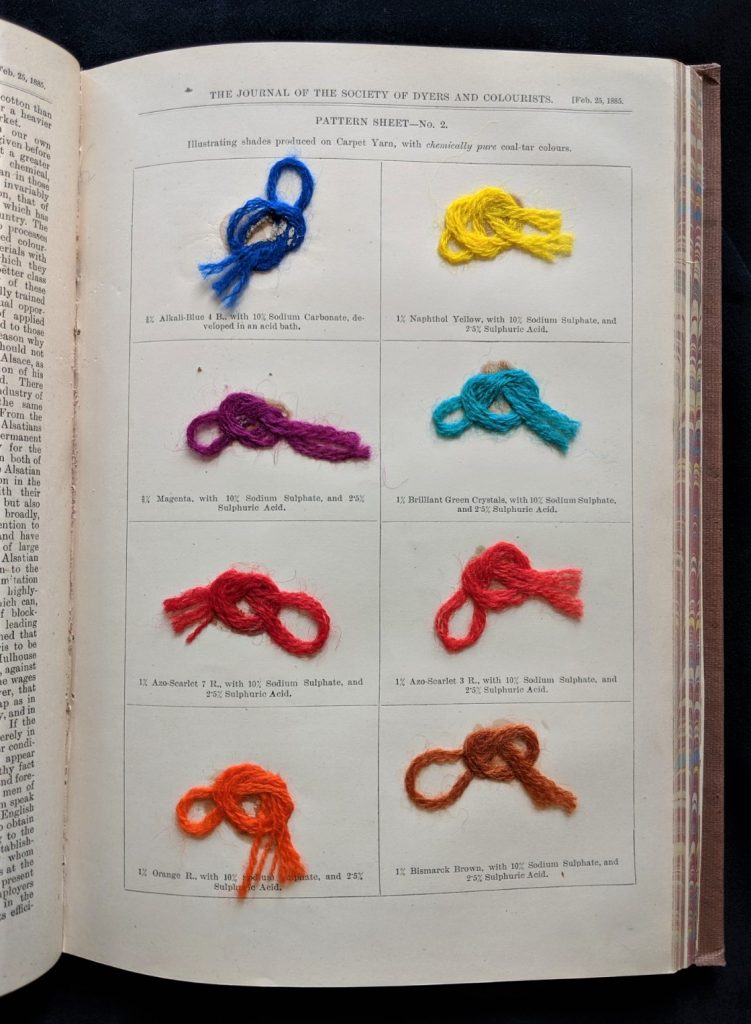
Textile colorist’s monthly samples are accompanied by “practical recipes” – formulas guaranteed to reproduce the vivid colors presented, given that “the proportions are strictly adhered to, and the manipulations be workmanlike”.
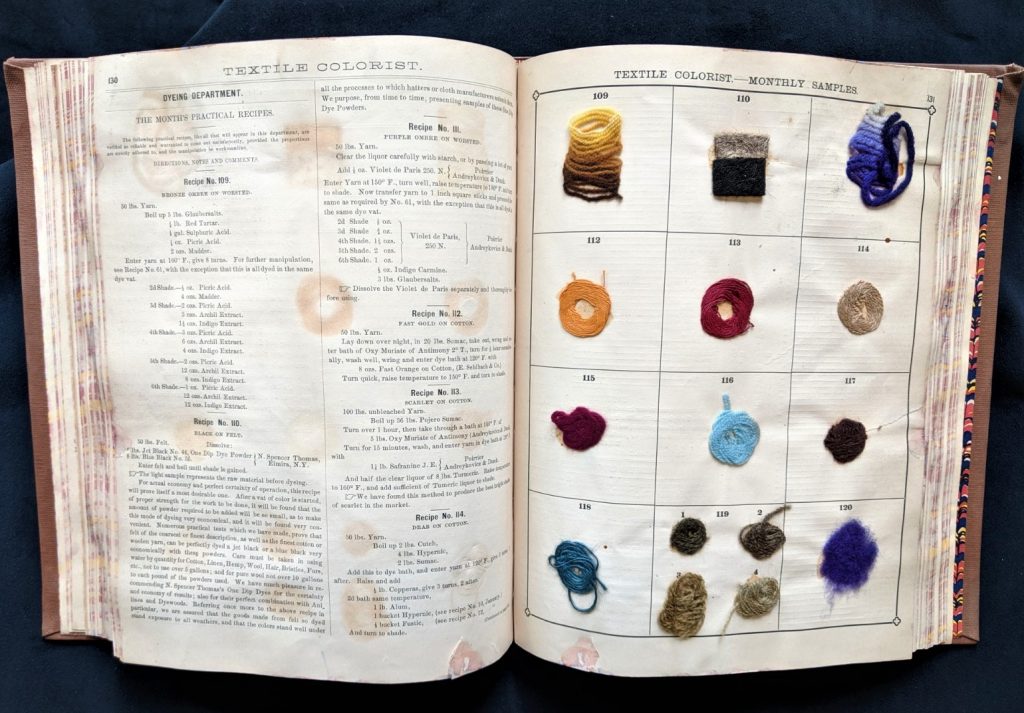
First published in Philadelphia in 1879, the Textile colorist focuses more on the dye industry, publishing price lists, tips, and advertisements.
While the Textile colorist ended its run in the 1940s, the Society of Dyers and Colourists continues to publish their journal, as well as the Colour Index International, a joint publication with the American Association of Textile Chemists and Colorists. In 1956, the AATC, SDC, and 26 other professional organizations converged in New York City to celebrate the 100th anniversary of William Perkin’s discovery. The proceedings of the week-long conference were bound and published in – of course – a mauve tome.

Scientific inquiry rarely follows a straight path and breakthroughs can happen in the most extraordinary ways. One of the many small joys of assisting with research is watching how scientists learn from failures, and occasionally find unexpected success.
William Henry Perkin set up a lab in his parents’ attic and attempted to finish a homework assignment that his professor had given him as a whim. He hoped to create medicine from toxic waste; instead, he created an entirely new industry.
163 years later, scientists continue to follow in Perkin’s footsteps researching mosquitoes and mauve.
The following additional resources are available at the Museum Support Center Library:
The history of dyes and textiles:
- Proceedings of the Perkin Centennial, 1856-1956 sponsored by the American Association of Textile Chemists and Colorists.
- The art of dyeing in the history of mankind by Frank Brunello
- Colour: making and using dyes and pigments by François Delamare
- The chemical technology of dyeing and printing by Louis Diserens
- The study of colour in textiles: imperial purple to denim blue by Susan Kay-Williams
- Journal of the Society of Dyers and Colourists, vol. 1, 1885—vol.116, 2000
- Textile Colorist, 1, 1879—vol. 70, 1948
- Standard color card of America by the Textile Color Card Association of the U.S.
Mosquitoes, vector-borne diseases, and malaria:
- Disease transmission by insects: its discovery and 90 years of effort to prevent it by James R. Busvine.
- Mosquitoes and their relation to disease: their life-history, habits, and control by F.W. Edwards.
- Mosquitoes of medical importance by Richard H. Foote and David R. Cook
- Mosquito surveys: a handbook for anti-malarial and anti-mosquito field workers by Malcolm E. MacGregor
- The biology of mosquito-borne diseases by P. F. Mattingly
- Indian insect life: a manual of the insects of the plains (tropical India) by H. Maxwell-Lefroy. (This book is available for adoption!)
- Annotated bibliography mosquito-borne diseases in Southeast Asia and Sri Lanka – 1989 by SEAMEO-TROPMED National Center of Thailand
- Malaria and the DDT Story by Richard Tren and Roger Bate
Learn more about the science of color in the Smithsonian Libraries’ online exhibit, Color in a New Light.


Be First to Comment